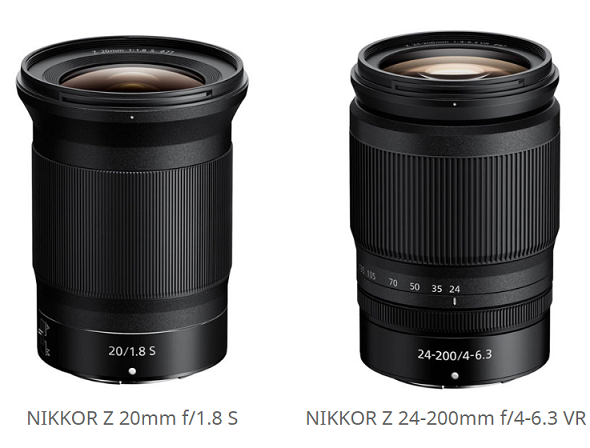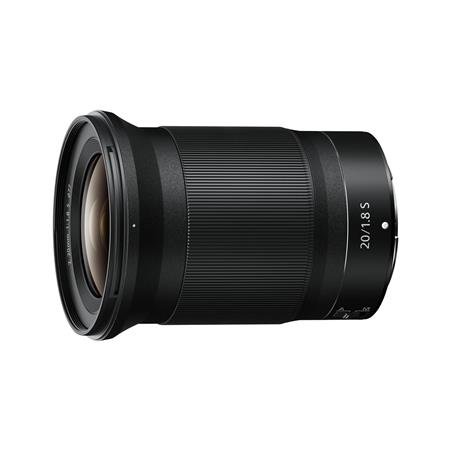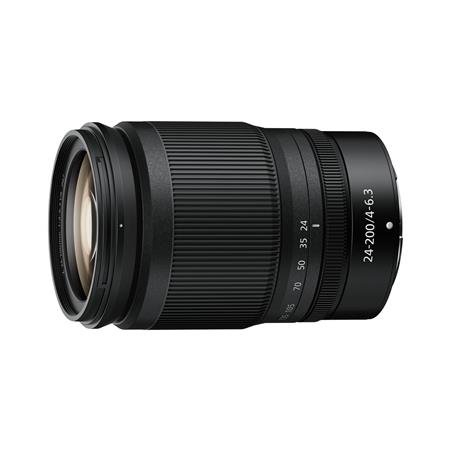Nikon D6, Z 20mm f/1.8 S & Z 24-200mm f/4-6.3 VR Lenses Announced
Today Nikon officially announced the new Nikon D6, Z 24-200mm f/4-6.3 VR & Z 20mm f/1.8 S Lenses. The US price of Nikon D6 is $6,496.95 and it will be released in April, 2020. Now the Nikon D6, Z 20mm f/1.8 S & Z 24-200mm f/4-6.3 VR Lenses are available for pre-order at B&H & Adorama. Order now if you are interested.
Pre-order links:
Nikon D6: $6,496.95 at B&H & Adorama
Nikon NIKKOR Z 20mm f/1.8 S Lens: $1,046.95 at B&H, Adorama
Nikon NIKKOR Z 24-200mm f/4-6.3 VR Lens: $896.95 at B&H, Adorama
Nikon NIKKOR Z 20mm f/1.8 S Lens Key Features:
- A focal length of 20 mm that enables dynamic imaging.
- Adoption of three aspherical lens elements and three ED glass elements ensures images that are incredibly sharp and clear all the way to the extreme edges of the frame, even at maximum aperture, regardless of shooting distance.
- Excellent point-image reproduction capability that ensures the rendering of point light sources as point images.
- An ultra-wide-angle lens that manages to achieve beautifully smooth bokeh that dramatically emphasizes the primary subject.
- Adoption of a multi-focusing system* realizes sharp and clear images, even with shooting at close distances.
- Adoption of Nano Crystal Coat effectively reduces the ghost and flare that landscape shots including the sun can cause.
- Incredible control over the distortion normally so common with ultra-wide-angle lenses, even at the extreme edges of the frame.
- Adoption of a stepping motor (STM) and control ring realizes quiet operation and a smooth operational feel with video recording.
- Designed with consideration given to dust- and drip-resistant performance, and equipped with an electromagnetic aperture diaphragm mechanism for accurate aperture control.
- Operation consistent with other NIKKOR Z lenses in the f/1.8 maximum aperture series, enabling smooth transition when switching lenses.
Nikon NIKKOR Z 24-200mm f/4-6.3 VR Lens Key Features:
- 8.3x zoom that covers a broad range of focal lengths, from 24 mm to 200 mm.
- Adoption of one aspherical ED glass element, two ED glass elements, and two aspherical lens elements achieves both superior optical performance and a compact and lightweight design.
- Zooming operation designed with equilibrium in mind, the center of gravity remains basically the same when the lens is zoomed out all the way for ideal balance.
- Extremely sharp and clear images all the way to the edges of the frame, beginning at maximum aperture.
- Adoption of ARNEO Coat realizes clear images in which ghost and flare effects are minimized.
- Despite being a telephoto zoom lens, a maximum reproduction ratio of 0.28x allow users to capture subjects for bold and magnificent expression of the intended subject.
- A minimum focus distance of 0.5 m (1.64 ft) at 24 mm and 0.7 m (2.30 ft) at 200 mm allows users to capture subjects from very short distances
- Designed with consideration for video recording with smooth tracking and the ability to respond to focus breathing.
- Adoption of a zoom ring and control ring realizes a smooth operational feel during video recording.
- Adoption of a stepping motor (STM) realizes fast, quiet, and accurate AF drive for both still-image and movie recording
- An optical vibration reduction (VR) mechanism that provides camera shake compensation equivalent to a 5.0-stop* increase in shutter speed.
- Designed with consideration of dust- and drip-resistant performance, and fluorine coat adopted for superior protection against dust, water, grease, and dirt.
Press Release:
Nikon releases the D6 digital SLR camera
The flagship model with the most powerful AF in Nikon history
TOKYO – Nikon Corporation (Nikon) announces the release of the Nikon D6 FX-format digital SLR camera, a new flagship model that responds to the needs of professional sports photographers and photojournalists.
Development of this product was announced on September 4, 2019.With the new D6, Nikon has realized the most powerful AF performance in its history through significant improvements over its predecessor, the Nikon D5 (released in March 2016). All focus points in the new, densely packed 105-point AF system utilize cross-type sensors, and all are selectable. The AF sensor built into the D6 is approximately 1.6x denser, and supports three times the number of selectable cross-type focus points than the D5, demonstrating superior focusing performance. The group-area AF option so popular with users of the D5 has evolved even further with support for 17 custom arrangements from which users can choose depending upon the scene or way the intended subject moves for precise capturing of decisive moments. The new dedicated AF engine developed for the D6 enables high-speed continuous shooting at up to approximately 14 fps*1 with all focus points working to keep the subject in focus for improved subject-tracking performance. In addition, adoption of a new algorithm enhances the camera’s ability to maintain focus on the intended portion of a subject without responding to those that pass through the frame.
The D6 also contributes to a faster on-site post-shooting workflow that is so vital to professional users. It does so with new functions that enable faster transmission of decisive photos, including one that allows photographers to transmit their winning images first with a flick operation using the camera monitor that moves the current image to the top of the waiting list*2, and another that enables simultaneous recording of two JPEG images with different size and quality settings — a smaller one suited to transmission and a larger one for editing, for example. What’s more, the D6 supports the same 1000BASE-T Ethernet standard as the D5, with an approximate 15% increase in its transmission speed. Together with the built-in Wi-Fi® capability, it makes for a complete response to the wired and wireless networking needs of professional photographers. Further, equipping the camera with a GPS function*3 enables acquisition of accurate date, time, and location information.
The D6 offers increased usability while inheriting the D5’s operability and reliable hold. Usability has been refined with improved connector arrangement and increased visibility for the top control panel and LCD monitor when button illumination is used in dark situations, providing professional photographers with even greater support. In addition, the D6 not only offers the strength and durability, and dust and drip resistance that allow Nikon flagship models to continue working in even the tough environments, but it has also been equipped with a security slot that supports connection of anti-theft cables that can keep the camera safe during remote operation.
The D6 is the flagship Nikon digital SLR camera that provides all the support professional sport photographers and photojournalists to perform at their best. It supports a rich lineup of NIKKOR F mount lenses, from ultra-wide-angle to super-telephoto, allowing photographers to capture decisive, once-in-a-lifetime shots, and fully responds to the needs of professional photographers who must deliver those images as soon as they are captured.
- *1Continuous shooting rate varies with lens used, aperture settings, etc.
- *2When connected to a computer or FTP server via Ethernet or using the WT-6/A/B/C Wireless Transmitter (optional).
- *3GPS function is not available in some countries or regions.
Primary Features
- 1.The most powerful AF system in Nikon history with 105 densely packed cross-type focus points
The D6 is equipped with a newly developed, densely packed 105-point AF system with which all focus points utilize cross-type sensors and all can be selected. The new focus point layout and the use of a triple-sensor arrangement for each focus point achieve AF coverage that is approximately 1.6x denser than that of the D5. The D6 also enables pinpoint focusing on the intended portion of a subject with approximately three times the number of selectable cross-type focus points as its predecessor. In addition, the group-area AF option popular with users of the D5 has evolved even further with support for 17 custom arrangements from which users can choose according to the scene or subject movement.
The D6 also demonstrates superior low-light AF performance. The center focus point works down to -4.5 EV*1 and the others to -4 EV, making autofocus possible even in dark situations or with low-contrast subjects. In addition, the dedicated AF engine newly developed for the D6 makes it possible for all focus points to work to maintain focus, even with high-speed continuous shooting at approximately 14 fps. The camera’s ability to maintain focus on the intended portion of a subject has also been increased — especially clear when Custom Setting a3 “Focus tracking with lock-on”*2strength is set higher. This allows photographers to maintain focus on an athlete’s face, for example, even if that athlete is a runner or table tennis player whose face is temporarily obstructed by a hand or paddle.
The Advanced Scene Recognition System, which uses a 180K-pixel RGB sensor, offers even greater performance with the EXPEED 6 image-processing engine’s superior processing capabilities in addition to the vast amount of information provided by the new dedicated AF engine. The D6 is also the first digital SLR camera*3 capable of placing priority on the subject’s eye with autofocusing in auto-area AF and 3D-tracking modes, allowing photographers to concentrate on framing portraits.
- *1At ISO 100, 20°C/68°F.
- *2With continuous-servo AF autofocus mode.
- *3As of February 12, 2020 based on research conducted by Nikon. With phase-detection AF using the AF sensor module.
- 2.Equipped with a variety of functions that make for a more efficient post-shooting workflow
The D6 responds to the needs of professional photographers who require the ability to deliver their winning images as quickly as possible by placing the best images at the top of the waiting list. The photographer needs only to use a flick operation in the upward direction to add the current image displayed on the monitor with playback to the top of the queue. There is also a function designed especially for those who only shoot JPEG. This function allows for the simultaneous recording of two JPEG images with different image size and quality settings, which is convenient for separating images that will be transmitted from those that will be edited.
The D6 supports the same 1000BASE-T Ethernet standard as the D5, with an approximate 15% increase in transmission speed. The camera also supports a number of options for wireless networking. In addition to conventional wireless networking using the WT-6/A/B/C Wireless Transmitter (optional), the D6 also offers built-in 2.4- and 5-GHz*1 Wi-Fi®. What’s more, stills, including those recorded in NEF (RAW)*2 format, and video recorded with the camera can be uploaded to a smart device*3 using the SnapBridge app. Support for GPS satellites, GLONASS satellites and Quasi-Zenith satellites enables accurate date, time, and location information acquisition with shooting.
- *1Available in station mode; not available in some countries or regions.
- *2Be sure to use the latest version of the SnapBridge app.
- *3The iPhone®, iPad®, iPod touch®, and Android™ devices running the SnapBridge app can be used. The SnapBridge app can be downloaded free of charge from the App Store® and Google Play™. See Nikon’s website for further information.
- 3.Superior image quality and reliability that allow users to concentrate on shooting
The D6 has an effective pixel count of 20.8 megapixels, and is equipped with a Nikon FX-format CMOS sensor and EXPEED 6 image-processing engine that contribute to a broad range of standard ISO sensitivities — ISO 100 to 102400. Sharpness and clarity are preserved and noise is effectively reduced, even at high sensitivities. Auto white balance stability and precision have been increased for clearer, more natural colors with no color cast in skin tones. The D6 also supports recording of 4K UHD video.
The D6 is constructed of the same magnesium alloy as the D5, ensuring a strong and durable, dust- and drip-resistant body that never misses decisive moments, even under the tough conditions. The layout of operational controls has been refined for increased usability, and a security slot that supports connection of anti-theft cables has been added to help keep cameras safe during remote operation.



